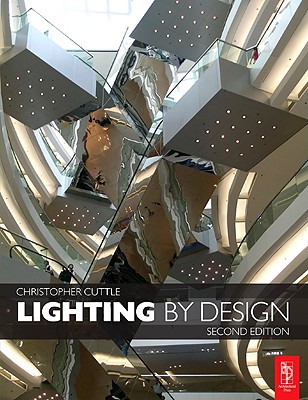

| LIGHTING BY DESIGN (2e) Christopher Cuttle Amsterdam: Elsevier, 2008 |
Rating: 4.0 High |
|||
| ISBN-13 978-0-7506-8768-3 | ||||
| ISBN-10 0-7506-8768-1 | 247pp. | SC/LF/FCI | $80.00 | |
The author explains:
"The need for this book arises from the fact that many architects and interior designers do not envision electric lighting as part of their design philosophies." – Page vii |
Thus motivated, Christopher Cuttle has produced a book which aims to teach architects to complete their philosophies, thereby enabling them to design buildings which embody their aesthetic messages both by night and by day.
Not being an architect, I cannot judge how well he succeeds. My only interest in reading the book was to learn about the techniques of measuring interior light quantity and quality. I turned first to Chapter 3, "Measurable Characteristics of Lighting." There I learned that
"There are many ways of measuring lighting. The ones that matter to a lighting designer are those that relate to the observation-based experience of lighting. It is for this reason that readers are encouraged to accompany observation with measurement." "The two sections in this chapter deal with illuminance-based and luminance-based measurements. In both cases, light is evaluated according to the photopic-adapted visual response (See Appendix A1) which ignores colour. It is possible to obtain a chroma-meter, which is an advanced type of illuminance meter that gives readings of illuminance, chromaticity, and colour temperature, but usually designers rely on colour data given by lamp manufacturers." – Page 125 |
The difference is that illuminance is a wide-area measurement (ideally hemispherical) while luminance looks at small segments of the scene.
I had to go back and read the first two chapters to catch up on some of the terminology. For example, "photopic" means light levels under which human color vision operates, and photopic-adapted means that this level of lighting exists long enough for eyes to adjust to it — in other words, normal illumination. Cuttle gives us a detailed, highly theoretical treatment involving specialized terminology (Kruithof Effect, luminance contrast, retinal illuminance, RVP plateaus, Color Mismatch Vector) which convinced me I won't start designing lighting systems tomorrow.1
I'm sure that Cuttle knows his subject, and that this is a very worthwhile book — for specialists. A list of references is provided, as is a list of recommended reading list. Finally there is a very complete index. But someone looking for an introduction to the measurement of light levels that will enable them to guarantee enough illumination for close, detailed work like electronic assembly will not find it here.

 To contact Chris Winter, send email to this address.
To contact Chris Winter, send email to this address.